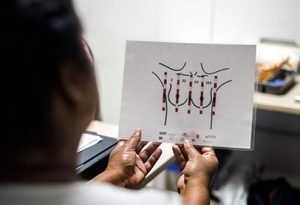Leidy woke up one morning in 2011 to find herself blind. At that time, Francia had already lost her sight. Deprived of sight, these women have developed another sense; the sense of touch through which today, in Colombia, they detect breast cancer.
Leidy Garcia and Francia Papamija are two of the five blind women or visually impaired who are trained in Cali (western Colombia) to prevent this cancerous disease, which is to-date the most widespread in the country with 7000 new cases each year and 2500 deaths.
In 2015, they adopted the method of the German physician Frank Hoffmann. For about ten years, he argued that blind people have facilities to detect nodules (agglomerates of cells) that are often the first symptom of the disease.
“People with visual impairments have an increased sensitivity, an advanced sense of touch that allows them to better distinguish the elements and thus allowing a diagnosis”, affirmed surgeon Luis Alberto Olave to AFP, coordinator of the program “Hands that save lives” at the San Juan de Dios Hospital in Cali.

Five women aged between 25 and 35, including one Mexican, were selected. They were not supposed to have any vascular or neurological problems that could alter their sensitivity. They were later trained as auxiliaries of tactile examinations. Since then, they have received more than 900 patients.
Overcome prejudices and mistrust
“We are fighting a prejudice that because we have a disability we cannot think or be autonomous,” said Francia, 35, who lost her sight as a result of a retinal detachment at the age of seven.
Cali hospital officials have realized that the examinations performed by these women gave “better” results than the ones following the usual procedure. “The clinical exam they perform is more elaborate, lasts longer, which gives patients a feeling of comfort they do not have with a traditional doctor,” Dr. Olave added.
While a self-examining woman can detect 15 to 20mm nodules and a doctor is able to detect a10mm nodule, blind aids can detect 8mm nodules.
Leidy almost totally lost sight six years ago. Her career as a topography engineer stopped overnight due to a cerebral thrombosis that blinded her left eye and severely impaired her right.
Leidy palpates the breasts of his patients by guidance with a yellow and red ribbon, which has a raised pattern for every centimeter to locate the possible nodules. When she detects a suspicious mass, she reports it to the doctor who, depending on the case, can order additional tests to confirm whether or not cancer is present. The initial examination lasts up to 45 minutes in comparison to the traditional method which lasts for up to 10min.
Francia and Leidy say that patients are sometimes curious, others suspicious. Some do not even speak to them, others tell them the story of their life.
Source of employment
Before becoming trained in this method of diagnosis, Francia and Leidy were out of work, as 62% of the 500,000 visually impaired in Colombia, which counts seven times more than the average population in this country of 48 million, according to the National Institute of the Blind.
Dr. Olave believes that it is a source of employment for the visually impaired and he hopes to start a new training in the first quarter of 2018. “In developing countries, whose access to diagnostic technologies is sometimes limited”, the manual examination “is very important,” he explains.
His two assistants, for their part, intend to demonstrate that they can save lives and that it is society that treats them as invalids.


